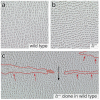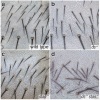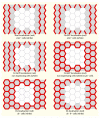Planar cell polarity: one or two pathways?
- PMID: 17563758
- PMCID: PMC2747024
- DOI: 10.1038/nrg2125
Planar cell polarity: one or two pathways?
Abstract
In multicellular organisms, cells are polarized in the plane of the epithelial sheet, revealed in some cell types by oriented hairs or cilia. Many of the underlying genes have been identified in Drosophila melanogaster and are conserved in vertebrates. Here we dissect the logic of planar cell polarity (PCP). We review studies of genetic mosaics in adult flies - marked cells of different genotypes help us to understand how polarizing information is generated and how it passes from one cell to another. We argue that the prevailing opinion that planar polarity depends on a single genetic pathway is wrong and conclude that there are (at least) two independently acting processes. This conclusion has major consequences for the PCP field.
Figures






References
-
- Brenner S. My Life in Science. BioMed Central; 2001.
-
- Drubin D. In: Cell Polarity. Hames B, Glover D, editors. Oxford University Press; Oxford: 2000.
-
- Gho M, Schweisguth F. Frizzled signalling controls orientation of asymmetric sense organ precursor cell divisions in Drosophila. Nature. 1998;393:178–81. - PubMed
-
- Lawrence PA. Development and determination of hairs and bristles in the milkweed bug, Oncopeltus fasciatus (Lygaeidae, Hemiptera) J. Cell Science. 1966;1:475–498. - PubMed
Publication types
MeSH terms
Grants and funding
LinkOut - more resources
Full Text Sources
Molecular Biology Databases

